Related Research Articles

The Local Group is the galaxy group that includes the Milky Way. It has a total diameter of roughly 3 megaparsecs (10 million light-years; 9×1019 kilometres), and a total mass of the order of 2×1012 solar masses (4×1042 kg). It consists of two collections of galaxies in a "dumbbell" shape; the Milky Way and its satellites form one lobe, and the Andromeda Galaxy and its satellites constitute the other. The two collections are separated by about 800 kiloparsecs (3×106 ly; 2×1019 km) and are moving toward one another with a velocity of 123 km/s. The group itself is a part of the larger Virgo Supercluster, which may be a part of the Laniakea Supercluster. The exact number of galaxies in the Local Group is unknown as some are occluded by the Milky Way; however, at least 80 members are known, most of which are dwarf galaxies.
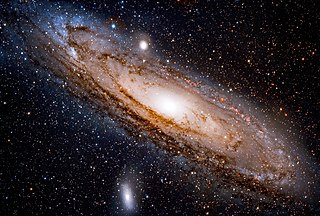
The Andromeda Galaxy, also known as Messier 31, M31, or NGC 224 and originally the Andromeda Nebula, is a barred spiral galaxy with the diameter of about 46.56 kiloparsecs approximately 765 kpc from Earth and the nearest large galaxy to the Milky Way. The galaxy's name stems from the area of Earth's sky in which it appears, the constellation of Andromeda, which itself is named after the princess who was the wife of Perseus in Greek mythology.

The Pegasus Dwarf Spheroidal is a dwarf spheroidal galaxy about 2.7 million light-years away in the constellation Pegasus. The Pegasus Dwarf is a member of the Local Group and a satellite galaxy of the Andromeda Galaxy (M31).

The Pegasus Dwarf Irregular Galaxy is a dwarf irregular galaxy in the direction of the constellation Pegasus. It was discovered by A. G. Wilson in the 1950s. The Pegasus Dwarf is a companion of the Andromeda Galaxy in the Local Group.

Messier 110, or M110, also known as NGC 205, is a dwarf elliptical galaxy that is a satellite of the Andromeda Galaxy in the Local Group.
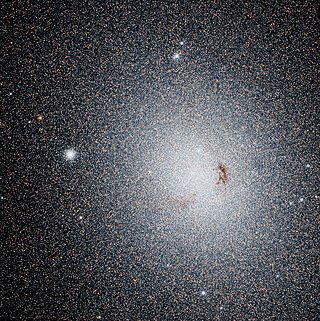
NGC 185 is a dwarf spheroidal galaxy located 2.08 million light-years from Earth, appearing in the constellation Cassiopeia. It is a member of the Local Group, and is a satellite of the Andromeda Galaxy (M31). NGC 185 was discovered by William Herschel on November 30, 1787, and he cataloged it "H II.707". John Herschel observed the object again in 1833 when he cataloged it as "h 35", and then in 1864 when he cataloged it as "GC 90" within his General Catalogue of Nebulae and Clusters. NGC 185 was first photographed between 1898 and 1900 by James Edward Keeler with the Crossley Reflector of Lick Observatory. Unlike most dwarf elliptical galaxies, NGC 185 contains young stellar clusters, and star formation proceeded at a low rate until the recent past. NGC 185 has an active galactic nucleus (AGN) and is usually classified as a type 2 Seyfert galaxy, though its status as a Seyfert is questioned. It is possibly the closest Seyfert galaxy to Earth, and is the only known Seyfert in the Local Group.

A dwarf spheroidal galaxy (dSph) is a term in astronomy applied to small, low-luminosity galaxies with very little dust and an older stellar population. They are found in the Local Group as companions to the Milky Way and to systems that are companions to the Andromeda Galaxy (M31). While similar to dwarf elliptical galaxies in appearance and properties such as little to no gas or dust or recent star formation, they are approximately spheroidal in shape and generally have lower luminosity.
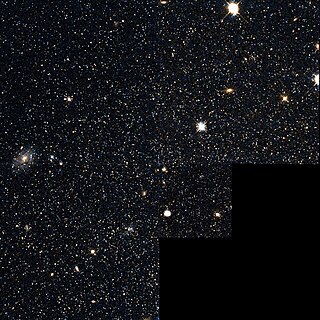
Andromeda I is a dwarf spheroidal galaxy (dSph) about 2.40 million light-years away in the constellation Andromeda. Andromeda I is part of the local group of galaxies and a satellite galaxy of the Andromeda Galaxy (M31). It is roughly 3.5 degrees south and slightly east of M31. As of 2005, it is the closest known dSph companion to M31 at an estimated projected distance of ~40 kpc or ~150,000 light-years.

The Sculptor Dwarf Galaxy is a dwarf spheroidal galaxy that is a satellite of the Milky Way. The galaxy lies within the constellation Sculptor. It was discovered in 1937 by American astronomer Harlow Shapley using the 24-inch Bruce refractor at Boyden Observatory. The galaxy is located about 290,000 light-years away from the Solar System. The Sculptor Dwarf contains only 4 percent of the carbon and other heavy elements in our own galaxy, the Milky Way, making it similar to primitive galaxies seen at the edge of the universe.
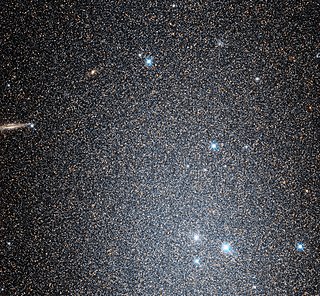
NGC 147 is a dwarf spheroidal galaxy about 2.58 Mly away in the constellation Cassiopeia. NGC 147 is a member of the Local group of galaxies and a satellite galaxy of the Andromeda Galaxy (M31). It forms a physical pair with the nearby galaxy NGC 185, another remote satellite of M31. It was discovered by John Herschel in September 1829. Visually it is both fainter and slightly larger than NGC 185. This means that NGC 147 is more difficult to see than NGC 185, which is visible in small telescopes. In the Webb Society Deep-Sky Observer's Handbook, the visual appearance of NGC 147 is described as follows:
Large, quite faint, irregularly round; it brightens in the middle to a stellar nucleus.

The Tucana Dwarf Galaxy is a dwarf galaxy in the constellation Tucana. It was discovered in 1990 by R.J. Lavery of Mount Stromlo Observatory. It is composed of very old stars and is very isolated from other galaxies. Its location on the opposite side of the Milky Way from other Local Group galaxies makes it an important object for study.
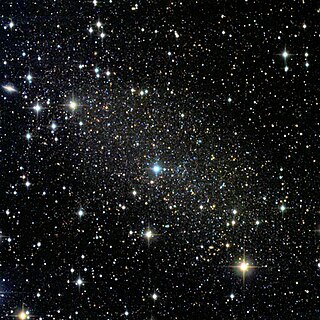
The Ursa Minor Dwarf is a dwarf spheroidal galaxy, discovered by A.G. Wilson of the Lowell Observatory, in the United States, during the Palomar Sky Survey in 1955. It appears in the Ursa Minor constellation, and is a satellite galaxy of the Milky Way. The galaxy consists mainly of older stars and seems to house little to no ongoing star formation. Its centre is around 225,000 light years distant from Earth.

The Draco Dwarf is a spheroidal galaxy which was discovered by Albert George Wilson of Lowell Observatory in 1954 on photographic plates of the National Geographic Society's Palomar Observatory Sky Survey (POSS). It is part of the Local Group and a satellite galaxy of the Milky Way galaxy. The Draco Dwarf is situated in the direction of the Draco Constellation at 34.6° above the galactic plane.

Andromeda II is a dwarf spheroidal galaxy about 2.22 Mly away in the constellation Pisces. While part of the Local Group, it is not quite clear if it is a satellite of the Andromeda Galaxy or the Triangulum Galaxy.

Andromeda IV is an isolated irregular dwarf galaxy. The moderate surface brightness, a very blue color, low current star formation rate and low metallicity are consistent with it being a small (background) dwarf irregular galaxy, perhaps similar to Local Group dwarfs such as IC 1613 and Sextans A. Arguments based on the observed radial velocity and the tentative detection of the RGB tip suggest that it lies well outside the confines of the Local Group.
Andromeda V is a dwarf spheroidal galaxy about 2.52 Mly away in the constellation Andromeda.

The Cassiopeia Dwarf (also known as Andromeda VII) is a dwarf spheroidal galaxy about 2.45 Mly away in the constellation Cassiopeia. The Cassiopeia Dwarf is part of the Local Group and a satellite galaxy of the Andromeda Galaxy (M31). In the sky, it appears behind the Milky Way's galactic plane, and so it is reddened by 0.194 magnitudes. With a luminosity of 1.8×107 L☉ and a stellar mass of 19.73×106 M☉, it is the brightest and most massive of the Andromeda Galaxy's dwarf spheroidal galaxy satellites. It also has the highest metallicity out of all of them.
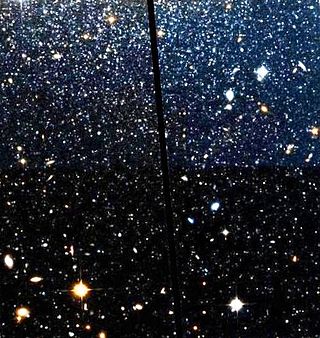
Cetus Dwarf is a dwarf spheroidal galaxy. It lies approximately 2.46 Million light-years from Earth. It is an isolated galaxy of the Local Group, which also contains the Milky Way. All of the most readily observable stars in the galaxy are red giants.

The Antlia Dwarf is a dwarf spheroidal/irregular galaxy. It lies about 1.3 Mpc from Earth in the constellation Antlia. It is the fourth and faintest member of the nearby Antlia-Sextans Group of galaxies. The galaxy contains stars of all ages, contains significant amounts of gas, and has experienced recent star formation. The Antlia Dwarf is believed to be tidally interacting with the small barred spiral galaxy NGC 3109.
References
- 1 2 3 4 5 6 7 8 9 "NASA/IPAC Extragalactic Database". Results for AndIII. Retrieved 2006-12-18.
- 1 2 McConnachie, A. W.; et al. (2005). "Distances and metallicities for 17 Local Group galaxies". Monthly Notices of the Royal Astronomical Society . 356 (4): 979–997. arXiv: astro-ph/0410489 . Bibcode:2005MNRAS.356..979M. doi:10.1111/j.1365-2966.2004.08514.x.
- ↑ van den Bergh, Sydney (January 1972). "Search for Faint Companions to M31". Astrophysical Journal. 171: L31. Bibcode:1972ApJ...171L..31V. doi:10.1086/180861.
- ↑ Da Costa, G. S.; et al. (July 2002). "The Dwarf Spheroidal Companions to M31: WFPC2 Observations of Andromeda III". The Astronomical Journal. 124 (1): 332–348. arXiv: astro-ph/0204109 . Bibcode:2002AJ....124..332D. doi:10.1086/340965. S2CID 12713887.
- ↑ Pritzl, Barton J.; et al. (May 2005). "The Dwarf Spheroidal Companions to M31: Variable Stars in Andromeda I and Andromeda III". The Astronomical Journal. 129 (5): 2232–2256. arXiv: astro-ph/0501083 . Bibcode:2005AJ....129.2232P. doi:10.1086/428372. S2CID 9749493.
